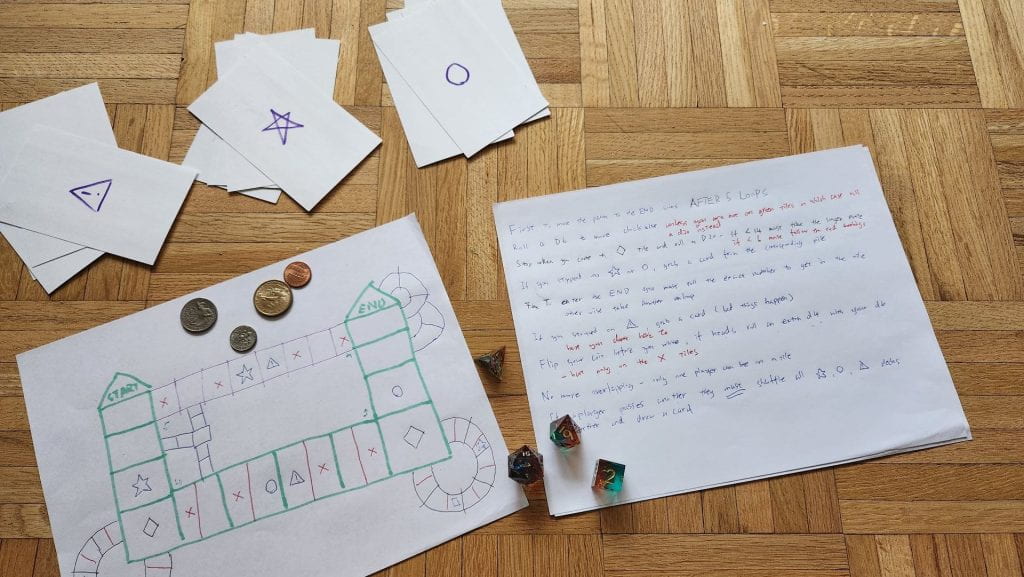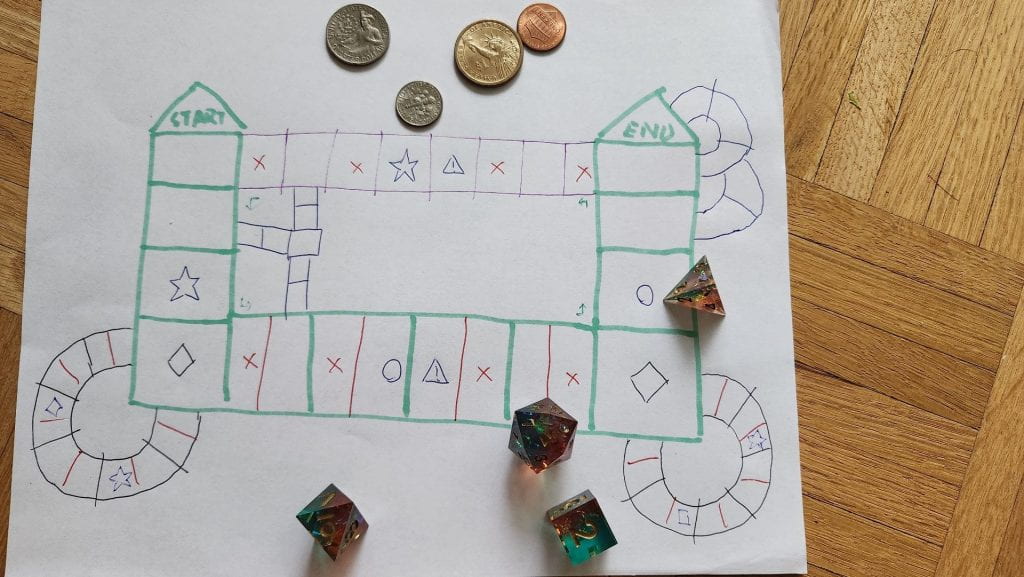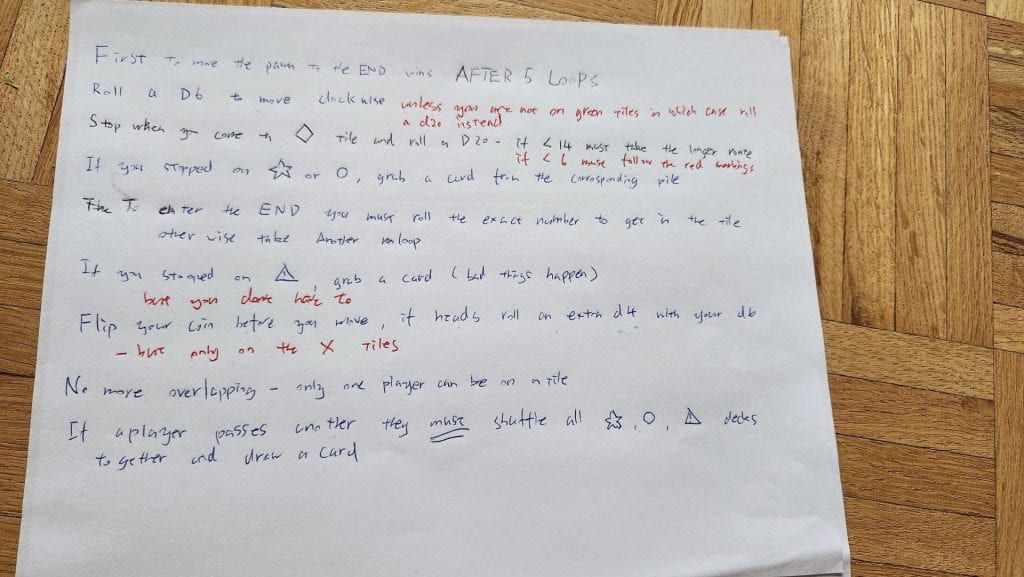
Projects
Score of a Cooking Game
Scores:
The players draw a dish card from the dish deck.
Carefully analyze the ingredients and picture of the dish on the Card
based on those materials, try to figure out the steps of making that dish
go through the “Score Guide”, one correct step for one point
the player with the most points wins!
https://docs.google.com/presentation/d/1CRKWg9k4eKjT3d3IgrubVLPblPhlXVvk/edit#slide=id.p1

The reason why I made this game is because I thought it would be interesting to combine culinary recipes with board games. Theoretically, since everyone is on their own team, this game can be played with an infinite amount of people as long as you have enough cards for them. But because we only have two cards available, I would say at this moment, it is a game for 1 -2 people.
This game invites players to explore their culinary intuition by analyzing pictures of dishes and a list of ingredients. These elements serve as a canvas for players to envision the steps necessary to bring these dishes to life. As players must come up with their own recipes based on the materials, it’s just like painting on an empty canvas.
Score #1 – Board Game Constructor
Instructions:
- Designed to be played with at least 3 or 4 players
- The score is separated into two phases: construction and play
- During construction each player takes turn to add to the game – by drawing on the board, adding rules, pieces or other elements of the game
- During play each player takes turn to play the game
- Each construction phase lasts one round and play phase lasts two
- Existing rules cannot be overridden or removed, but can be appended
- The score begins with a blank piece of paper, during the construction phase
Materials recommended:
Pen, paper, RPG dice, cards and anything that can be used as pawns
The aftermath of a play session:
Author’s statement:
My personal inspirations for a game about making games traces back to my elementary school days: with us being obsessed with computer games but unable to play during the day, we spent launch breaks after lunch breaks turning our notebooks into interactive games with only pencils and imagination.
In relation to our class reading, I think my score is mostly inspired by the Fluxus’s focus of delivering the performance over the final product, and its collaborative but loose nature during the process of creation. Additionally, the score can also be seen as an exquisite corpse, since each participator contributes to the game in turn as the game progress forward.
While I originally intended for there to be a clear instruction about needing to have a winner or an end state of the game, I decided to remove the rule so the players can decide what happens at the end, or if there needs to be an end at all. I believe that sometimes, having the goal of a game to be perpetuating said game can be just as interesting as having an outcome. In addition, as the rule stated, players can only add to a game, not to remove them. as I view the game to be like a big canvas, where things cannot be erased even though newer additions would eventually overwrite older ones – even if they are no longer visible, they still make up the work. Finally, as the playtesting shows, there is an endless amount of possible product of this score, and I think this fits nicely to the themes of Fluxus and some of Yoko Ono’s scores, where the process of creation is constant, yet the same starting condition can turn into a chaotic amount of products.
Clash Chess: The Score
As shown in the link.
Dinner Piece
Dinner Piece
Find a good afternoon
Walk to your favorite grocery market
Ask someone for their favorite course
Thank them for sharing
Get ingredients for that course
Hum and walk home
Appropriate that course in your favorite way
Enjoy it in the way you like
This score was designed to give the player a chance to have some simple time and just enjoy oneself. It does nothing difficult or aloof, which is something I want to erase from my artworks. It could be beautiful while serving a “purpose” that could aid a daily procedure. But again, I took my inspiration from Yoko Ono, and her artwork specialized in giving brief and elegant experiences. I didn’t aim to go as brief but there also was an element of trust that I took from her works, a bit of interaction with the world. It’s very important to feel not alone and content, I hope that this score could do something to help my audience understand this.
Score: Boundary Piece
Boundary Piece
Play tag with no boundaries.
Play tag with a reasonable boundary.
Play tag with an unreasonable boundary.
You may play hide-and-seek instead of tag.
Author’s Note:
This piece was heavily inspired by the work of Yoko Ono and the Fluxus artists. Yoko Ono’s elegant, poetic scores inspired the simple, repetitive style of this score. The alternative way to perform the score presented at the end is also something Yoko Ono does frequently in her book Grapefruit. Much of the Fluxus movement was interested in procedure and play. Tag (or hide-and-seek) is a very physical game. Playing it, especially with no boundaries, gets players moving through space, and actively experiencing life. The Fluxus artists were also concerned with modifying existing games, which I call back to here.
My score requests its performers to “play tag,” following whatever rules they understand that to mean. The rules of tag may vary wildly between different people, who grew up playing it in different environments. One thing tag does not have is a set end point. I recommend playing each step of this score with a short timer, but it could be played on a longer timer or even with some alternate win condition, if one understands tag to be played that way. Just like playing “proper” tag, this score is best performed outside, in an open space. Obstacles may or may not be present, and may or may not factor in to the performers’ conception of a (un)reasonable boundary.
This score was made with the specific purpose to make the performers think about boundaries in games. The score first asks you to play without boundaries, which, in my experience, does not work well. Players can just run away forever, never getting cornered by an impassable wall. Many playground disputes have arose from games of tag started with no established boundaries, over what is fair and reasonable. The score next asks you to create a reasonable boundary, making the performers consider what borders do facilitate a well-played game of tag. It concludes by asking the performers to play tag in an unreasonable boundary. This asks them to get creative. In both times performing this score, the performers went for an unreasonably small boundary, following the pattern established by the other two steps, but an unreasonable boundary could also be one with too many obstacles, or one of reasonable size but an over-specific, confusing shape.
My original conception of this score asked performers to play tag in an enclosed space, and then decrease the space until nobody can run, and play tag in the new enclosed space. I thought this was interesting, but did not leave room for interpretation and player expression, traits I admired in Yoko Ono’s work and wanted to include in my own score.
Compliment Cascades
Each morning, take a single die and cast it.
Memorize the number revealed.
Throughout the day, bestow compliments equal to that number.
Observe the faces you touch.
Witness the transformation in their spirits.
Take note of the reverberations.
A simple act, a profound impact.
“Compliment Cascades” is a call to embrace everyday kindness. Inspired by Yoko Ono and my mother’s unwavering insistence on me being a gentleman and treating others with respect, this artscore invites you to roll the dice of positivity.
Every morning, roll a die, and let the number guide you to compliment that many people throughout your day. It’s a simple gesture with a profound impact. In a world where small acts of kindness can make a big difference, this score empowers us all to brighten someone’s day with a genuine compliment.
Yoko Ono’s piece called Grapefruit had a major impact on my work as well as Allen Kaprow, who were both a part of the Fluxus movement. I took Yoko Ono’s collection of conceptual art and poetry and created these sets of instructions. I wanted the vibe of it to be similar to how she is commanding, while having a deeper meaning. I wanted people to realize our world is tense and divided because we do not treat each other like human beings with respect. I want people to put their differences aside and be genuine to each other. I wanted to show how easy it is to do so by simply taking a die and rolling it. Effortless and not complicated. Something that just… happens.
Kaprow advocated the elimination or at least reduction of the conventional boundaries between art and daily life. He thought art should be easily incorporated into our everyday experiences and environments rather than being restricted to certain places or items. He led the happenings movement, a type of art event that blurred the lines between art and life. This piece is supposed to do so, and just happen naturally.
Documentation: After implementing this into my every day routine for the last week, I respectfully decided to not take any pictures or video of me doing this, because I felt it is personal and should not be shared with others. However, I will say that seeing all of the smiles and lit up faces really makes my day. Just try it out for yourself and you’ll see 🙂
Score: Go Fish ?
Documentation:
- Looked around my room for an idea
- Saw deck of cards on my desk
- Thought about what game to play with those cards
- Then thought , “What if you can’t see your cards”
- Immediately go fish came to mind
Go fish?
Get a standard deck of cards
Shuffle deck of cards
Give each player 5 cards
*They can not look at their cards
Instead pick up your cards and have them face your opponent
The youngest goes first
Take a card from your opponent
You can either ask if you have a card or
You can ask if you have a pair in your hand
Notes:
After testing the game, we realized how you can easily get a pair but not even know it.
Let’s say you steal an opponent’s card to make a pair, but they also have a pair of that card in their hand. What do you do?
How far does your integrity go?

Making roommate play my game.
Artists Statement:
My goal from the beginning was to create a game that was simple yet had an interesting twist on an already existing playable game. I was inspired by all of the chess scores and some of the readings. I was especially inspired by Essential Questions of Life Chapter 3, when they showed artwork of objects that already existed but made it useless. I really liked the concept of re-inventing an existing idea but with an interesting spin. That’s when I looked at my deck of cards and thought “How can I introduce an interesting twist to a well known card game?” One of the first games that I thought of was Go Fish because it is a very simple game to play, and it is very important to know what cards you have to get the sets that you need. White chess was a big inspiration to me because it took a very well known game and added one simple change that completely altered the way the game was played.. Everything was white. Similarly, I wanted to change Go Fish. That’s when I had the idea; What if you were not able to see your own cards? I have to admit I thought that it was going to be impossible or extremely difficult to play, but my roommate and I were able to have fun playing the game. Although Go Fish? is a relatively straightforward game, there is still room for interpretation between players. Players are able to decide how they want to play the game and can even add their own rules or playstyles if they want. In creating Go Fish? My goal was to create a game that was both enjoyable and easy to learn and play. I really hope that my game was able to accomplish those goals, and will allow people to see more games in new ways, and create ways to change the game by adding or changing the fundamental rules.
Roll for Role
I wanted to create a score that could be played in a mutable way by its players. By placing the ‘fun maintenance’ on the players, I think the players become more attached to the game. However, they still needed a starting point, so I designed the Crow and Collector roles to be easily cycled/repeated as many times as necessary.
This game should be played with at least 4 people, each person should roll a d20, if its even they are a Crow, if its odd, they become a Collector. All tasks for a players assigned roll should be completed. Players should take turns rolling a single die. once all players have rolled once, the Creator role should be added in. Once at least one person has become the creator, the eliminator role may be added in.
Current role tasks should be visible to everyone playing (like on a projector or TV).
At any point, if players get ‘soft-locked’, for example: all players become crows and get stuck; the game is over.
Starting Script:
Score A: The Crow
– adorn a feather
– find a shiny item
– bring it to The Collector
– roll for role (d20)
Score B: The Collector
– adorn a pin
– until a Crow delivers an acceptable item to you, find a chair.
– if a crow gives you a shiny item, exchange for a snack
– roll for role (d20)
Score C: The Creator
– read through current roles and instructions
– add or edit only one thing
– roll for role (d20)
Score D: The Eliminator
– read through current roles and instructions
– delete only one thing
– roll for role (d20)
Concluding thoughts:
- This game in design as well as in testing works much better in locations where more than the starting number of players can be added. whether in a classroom or outdoors where more people can ask/be asked to join in, the more fun that this game gets
- I would have liked to add in a rule to the crow roll where if they choose not to give an item to a collector, then they can do something else instead to move on, however I wanted the focus to be on the crows’ loyalty/reliability on the collector to eat. adding the components to include this feature i think would have made the game too complicated
- maybe some rule like “either bring an item to the collector, or [some unenjoyable task], however each person playing can do [unenjoyable task] at most one time”
- however i didn’t get a chance to playtest with this sort of rule
- i feel like it could also be more interesting for the players to sort of “mad-libs” the original task so they feel more inclined/attached to it
- current game design will often end with players all becoming either crows or collectors, while it is technically possible to avoid this, players often do not think of it/realize in time
- One of the biggest issues with the creator role is that players can make rules that don’t make sense. whether it be to bad grammar or intention, this makes the game interesting but not usually in a good way because players don’t know what to do to complete their roles tasks
- game roles/rules should be visible to all players at all times
- because the rules can be modified, players can get confused when things are getting changed and no longer know what to do next
- rerolling needs a queue, otherwise it gets too confusing. One solution is to offer more dice so people can roll at the same time but I think this is worse.
- “What is a thing?” This line for the creator/eliminator is intentionally left vague. As long as the person doing the action can justify it is only one thing, i think it is fine whether they decide to delete a single word, line or even role.
Playtest notes and iteration:
https://docs.google.com/document/d/1_xUxZ0vbn7MoFV5XrkmDfuC-RPPDpOw8ydi4-ICfpLA/edit
Experiencing different life at the same time
Introduction:This a game or activity that players have to take a picture at the same time, even though they may be in different places and doing different things. But the time experienced by all is fixed, and photos taken at the same time can be compared with each other. Maybe other people’s lives are not always what they want, and their own lifestyle may be what many people dream of. We should be able to find arts in other people’s life, but most importanly in our own life.
Inspirations: Kaprow said, ‘The line between art and life should be kept as fluid, and perhaps as indistinct as possible. We use our eye to observe many things/events happened every single day. But sometimes we just ignore it, so this game force players to stop and actually observe the surroundings, art can be anything in your life. Cameras sometimes can helps you capture the moment. By putting everyone’s moment together it would be a wonderful piece because they are so random but they all happened at the same time on this planet.
Instructions:Players get together and agree on a time for the photo shoot, and a specified theme or anything that they feel like is art.
requirments: A Device that could capture photos( cell phone, digital camera, polaroid camera….)
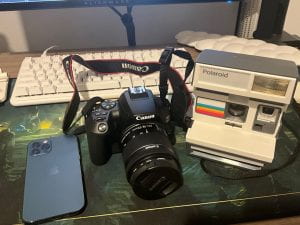
Timekeeper,Printer(optional)
examples: I ask my friends take a picture at 5PM today(including myself), no matter where they are or what they doing.
Me at 5 pm (Playing Cyberpunk 2077, I would called it Art):
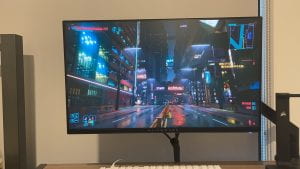
Peter at 5 pm (Studying Art design in SNELL):
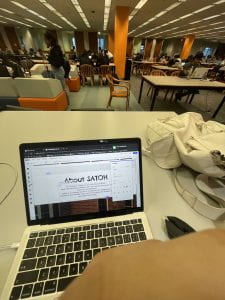
Jiang at 5 PM (exploring the city):

Justin at 5 PM(staying home and looking outside):

Discussions and Conclusion: Everyone wanted to do what I was doing at 5 pm, because they were either bored or very busy. I am the only one at that time staying at home and play video game. But I actually wanted to study like peter did at 5pm,however I wasn’t in the mood. I would also like to go out and walk around the campus, yet the weather was bad so I didn’t do it. In fact I am totally not regret about what I was doing at 5 pm because the Night City in Cyberpunk 2077 was so beatiful, it is an art piece that I can particiapte in.
